Knitting Yarns vs Weaving Yarns
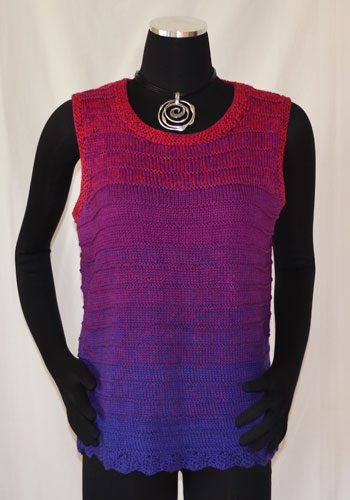

Which of our yarns can you use for knitting, and how do the yarns compare with the standard knitting terms such as Sport Weight or DK weight? You certainly can knit with weaving yarn, and weave with knitting yarns, but a little knowledge about the yarns and their purpose will help your knitting and weaving adventures be more successful.

Knitting yarns and weaving yarns are not created equal. Knitting yarns are designed to be lofty, soft and stretchy, whereas weaving yarns are designed to be strong, durable and not stretchy. These yarn characteristics are achieved through the fiber preparation and the spinning process. Weaving yarns are much more tightly twisted and hand weavers generally use two ply yarns to increase the yarn’s durability.
The extra twist in many weaving yarns can produce a knitted fabric that will tend to skew off to one side. This is a result of the twist that is on the yarn that isn’t compensated for in the knitting process. Our Tubular Spectrum™ Mercerized cotton yarns have a slightly lighter twist (about 8 twists per inch) and work reasonably well for knitting. The tank top shown above is knitted with three strands of 10/2 Tubular Spectrum™ yarn as one working end. Knitting those 3 strands together makes skewing less of a problem (it helps neutralize the extra twist) – and give you some incredible color blending options. See the samples below where 4 strands of 10 Blue, 10 Green and 10 Green Yellow are blended together to get a great ombre.
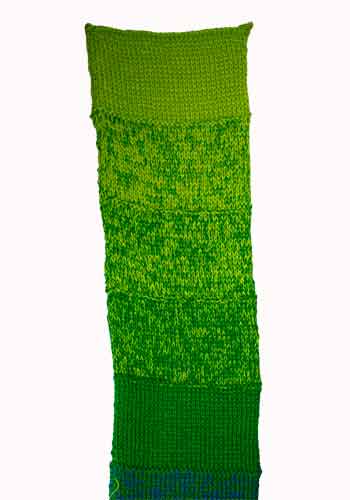
We created the following table as a starting point for using our cotton weaving yarns for knitting. Please sample the yarns before committing to a large project. No matter how much experience we have in a particular yarn, knitting varies so much with the operator of the knitting needles, and what works for us may not work for you. Please, please sample! And because most of our yarns are made from either cotton or hemp that 4″ to 6″ square can have lots of uses; think dish cloths, coasters and doll blankets.
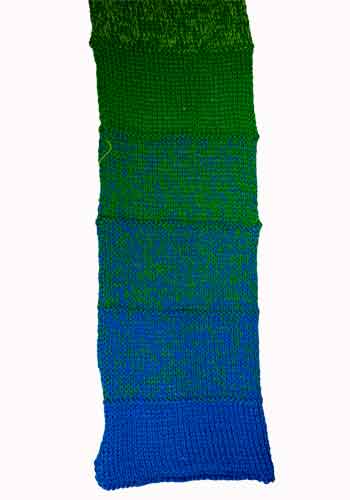
| Cotton Yarn Size | 1 Strand Yards/lb | 1 strand Knitting Category | 2 Strands Yards/lb | 2 strand Knitting Category | 3 Strands Yards/lb | 3 Strand Knitting Category |
|---|---|---|---|---|---|---|
| 3/2 | 1,260 | Sport/DK | 630 | Bulky | 420 | Bulky |
| 5/2 | 2,100 | Fingering | 1,050 | DK | 700 | Bulky |
| 8/2 | 3,360 | Lace | 1,680 | Sport | 1,120 | DK |
| 10/2 | 4,200 | Lace | 2.100 | Fingering | 1,400 | Sport |
| 20/2 | 8,400 | 4,200 | Lace | 2,800 | Fingering | |
Our unmercerized American Maid™ yarns have a slightly tighter twist, and the suitability of these yarns depends on the knitter. Many knitters have made beautiful items from our American Maid yarns. We have a limited supply of a 4 ply American Maid™ yarn that we intended specifically for knitters. It is available in all 5 natural colors, and a knitted sample both washed and unwashed are shown below. This yarn knits up beautifully on size 7-9 needles with a 16-20 gauge in stockinette stitch. If you like to knit fine yarns, you can use the 8/2 American Maid™ to make lovely soft sweaters and lace…you can knit miles of lace with a 1# cone of 8/2 American Maid™ Natural White yarn for a very reasonable price tag. The skewing of the knitted fabric depends on the knitter. Some knitters have no issues, some knitters have the fabric skew. Please sample to know how it goes for you!
On the flip side, the stretchiness of knitting yarns creates challenges for weavers. When you wind a warp of knitting yarn on a warping board, you will be stretching that yarn and will need to add extra yardage to your calculations. That way, when it relaxes in the final project, you will end up with the proper amount of yarn needed for your final project.
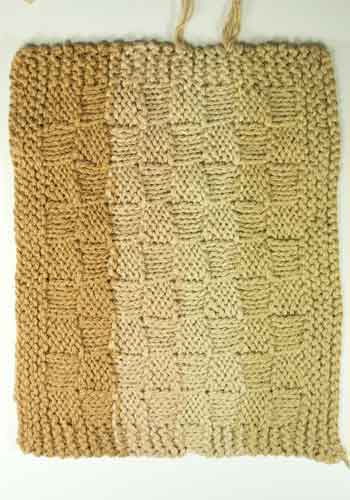
The final challenge of comparing weaving and knitting yarns lies in the different naming conventions of
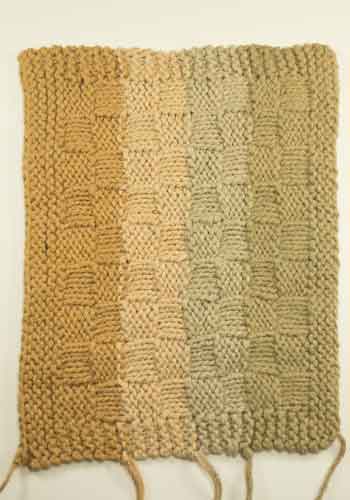
knitting versus weaving yarns. Knitting yarns use categories such as Bulky, DK weight, Lace and so on. These are general categories for the sizes of the yarns and don’t have hard and fast size rules attached to the yards per pound of any particular yarn. You compensate for that flexibility by changing the size of the needle that you use to get a particular gauge for your knitted item. In the weaving world, there are stricter guidelines for the sizing of yarn, and the various fiber types have their own size conventions. Cotton is based on a size 1 single ply yarn having 840 yards per pound. Then, the number has the number of plys attached to it as in 5/2. This is a size 5 yarn (840 yards x 5 = 4,200 yards for a size 5 yarn) with 2 plys. Thus, a 5/2 cotton yarn has 2,100 yards per pound. We do have a several charts showing the sizes of various weaving yarns and the number of yards/lb associated with those yarns. Click here for those Charts.
We hope this helps to give you a starting point for knitting with cotton weaving yarns. We would LOVE to hear from anyone who has used our yarns for knitting. Please share your knowledge with others as we frequently have questions about using our yarns for knitting.
Happy Knitting!


Hi
That was very informative. I was wondering if crocheting with your threads would also cause skewing. Specifically filet crochet bedspread, curtains and tablecloths. Also crocheting dresses.
I do somewhat understand your about explanation. But is it possible to make a chart that says 10/2 =?
10/3=
20/2=
8/2=
Or stitch gauge per inch for each of your sizes?
I’m a master at crochet but lousy at figuring this out.
My preferred sizes of crochet threads are #20, #10, #2, and sometimes 3 & 5
Thank you.
Thank you for such an informative page, especially about the twisting and bias, and the general quantitative conversion information. I look forward to trying some knitting with Tencel, which is harder to find in 100% form in knitting yarns.
Thank you for giving us this info. I am a hobby weaver and am not secure using knitting yarn. This article is great for understanding how “sport, fingering, etc compare to weaving yarn. What about yardage for these? Is there a consistency of yards per gram? For example: 50 grams of sport wool yarn or 50 grams of fingering cotton yarn.
Hi Sandy,
It seems that the fundamental difference between yarns designed for knitting and those designed for weaving is the amount of stretch in a yarn. Knitting yarns are designed to be stretchy, and so they have vague yardage guidelines. It may even be impossible for the manufacturer to know how many yards because how do you measure the yarn? Stretched out, at rest, somewhere in between? On the other hand, weaving yarns are designed to not be stretchy, so they have more accurate yardage numbers. This can be frustrating to those of us who started off as weavers. To come up with the table, I took a sample of knitting yarns that I had and those that I could find online to see what the average yards/lb were and based my judgement of where our yarns fit into that information. I will work to get a table for the yardage that I calculated added to this post soon.
Katzy